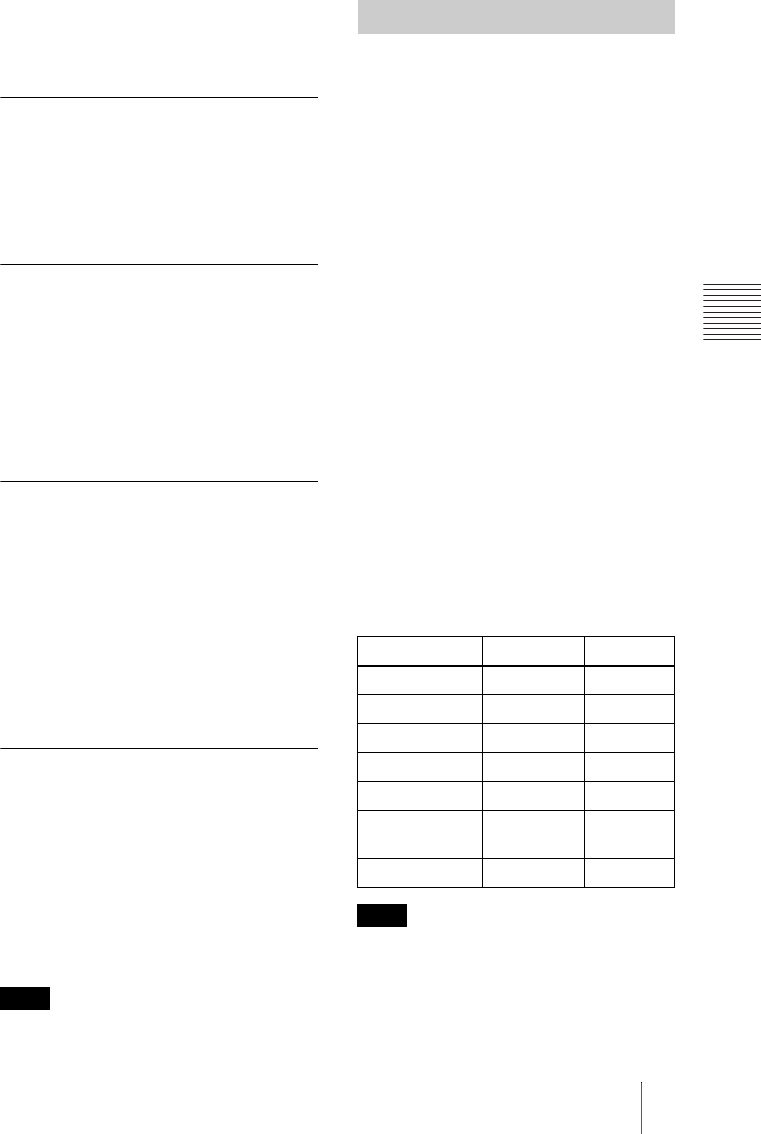
33
The INPUT SETTING Menu
Adjustments and Settings Using the Menu
an infringement of the rights of authors or
producers, which are legally protected.
Adjust Signal... Menu Items
Dot Phase
Adjusts the dot phase of the LCD panel and
the signal output from a computer.
Adjust the picture further for finer picture
after the picture is adjusted by pressing the
APA key.
Adjust the picture to where it looks clearest.
H Size
Adjusts the horizontal size of picture output
from a connector. The higher the setting, the
larger the horizontal size of the picture. The
lower the setting, the smaller the horizontal
size of the picture. Adjust the setting
according to the dots of the input signal.
For details on the suitable value for the
preset signals, see page 55.
Shift
Adjusts the position of the picture. H adjusts
the horizontal position of the picture. V
adjusts the vertical position of the picture.
As the setting for H increases, the picture
moves to the right, and as the setting
decreases, the picture moves to the left.
As the setting for V increases, the picture
moves up, and as the setting decreases, the
picture moves down. Use the < or the ,
key to adjust the horizontal position and the
M and m key for the vertical position.
Scan Converter
Converts the signal to display the picture
according to the screen size.
On: Displays the picture according to the
screen size. The picture will lose some
clarity.
Off: Displays the picture while matching
one pixel of input picture element to that
of the LCD. The picture will be clear but
the picture size will be smaller.
When XGA, SXGA, SXGA+ or UXGA signal
is input, this item will not be displayed.
This projector has 46 types of preset data for
input signals (the preset memory). When a
preset signal is input, the projector
automatically detects the signal type and
recalls the data for the signal from the preset
memory to adjust it to an optimum picture.
The memory number and signal type of that
signal are displayed in the INFORMATION
menu (See page 36). You can also adjust the
preset data through the INPUT SETTING
menu.
This projector has 20 types of user memories
into which you can save the setting of the
adjusted data for an unpreset input signal.
When an unpreset signal is input for the first
time, a memory number is displayed as 0.
When you adjust the data of the signal in the
INPUT SETTING menu, it will be
registered to the projector. If more than 20
user memories are registered, the newest
memory always overwrites the oldest one.
See the chart on page 55 to find if the signal
is registered to the preset memory.
Since the data is recalled from the preset
memory about the following signals, you
can use these preset data by adjusting “H
Size.” Make fine adjustment by adjusting
“Shift.”
When the aspect ratio of input signal is other
than 4:3, a part of the screen is displayed in
black.
Note
About the Preset Memory No.
Signal Memory No. SIZE
Super Mac-2 23 1,312
SGI-1 23 1,320
Macintosh 19" 25 1,328
Macintosh 21" 27 1,456
Sony News 36 1,708
PC-9821
1,280 × 1,024
36 1,600
WS Sunmicro 37 1,664
Note


















